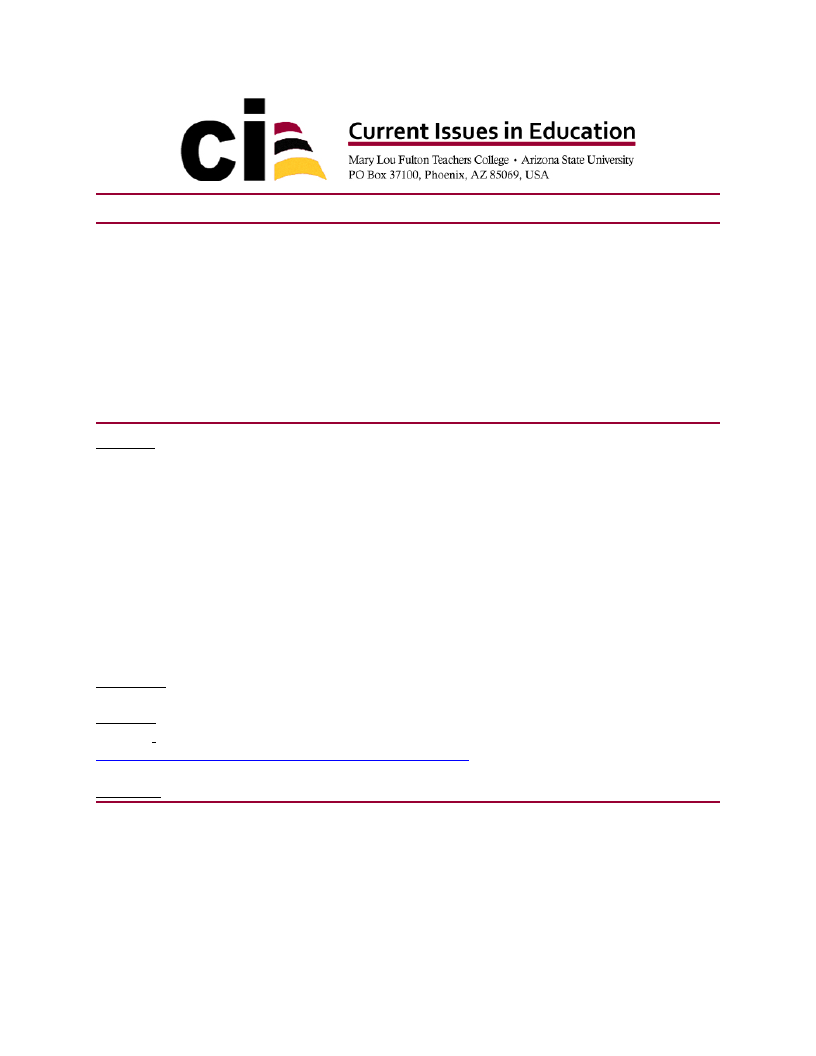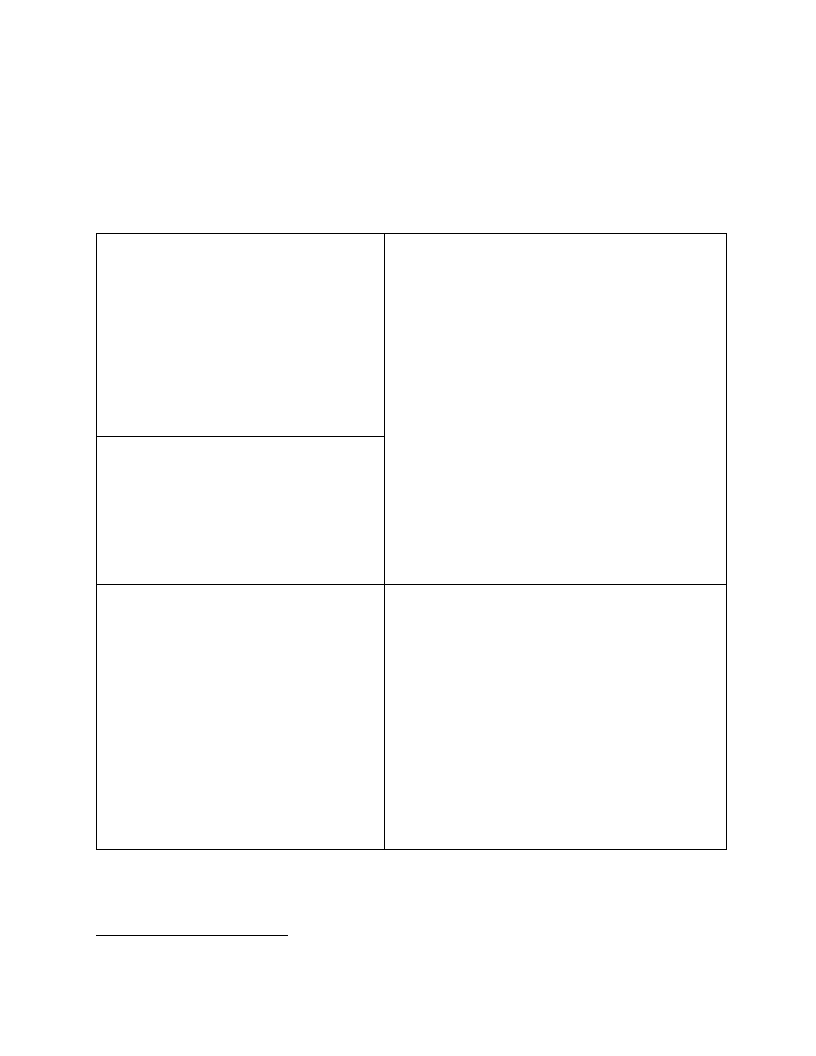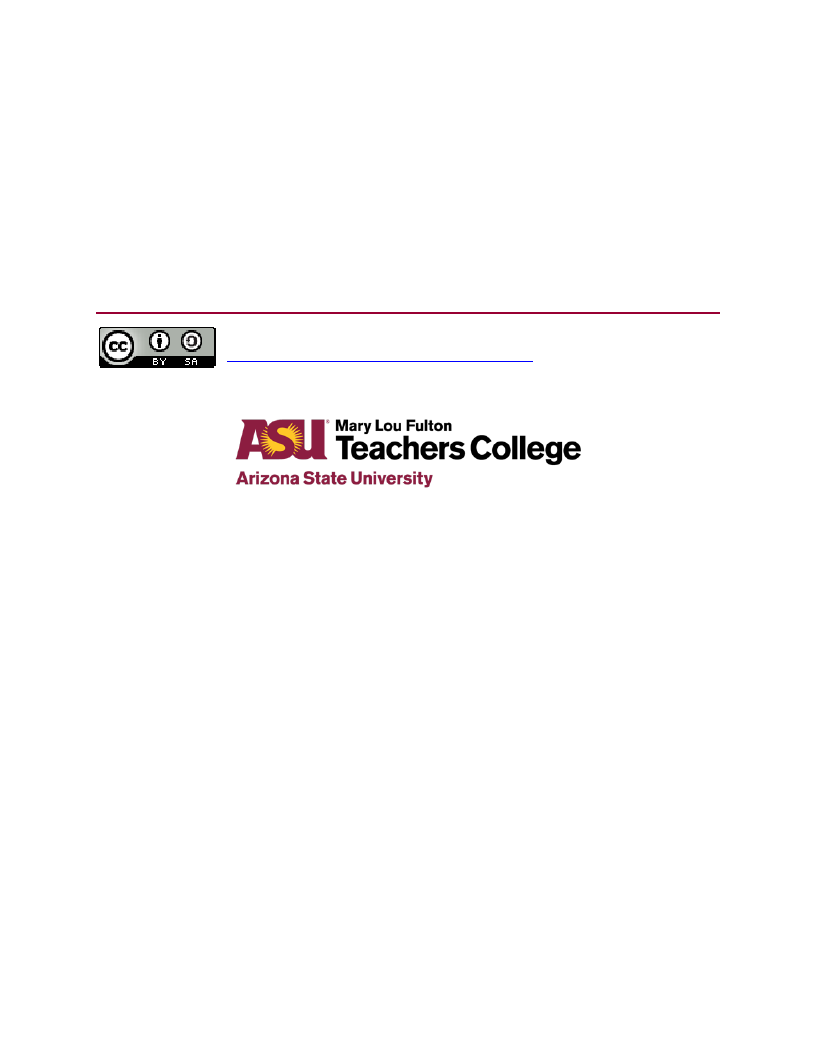
Volume 22, Issue 2
May 18, 2021
ISSN 1099-839X
Curriculum, Aesthetics, and Social Justice:
From the Common to the Exceptional
Alicia Brianna Saxe
University of Denver
Jodie L. Wilson
University of Denver
Abstract: The unique capacity of aesthetic methods to provoke a variety of consequential
educational outcomes has attracted considerable scholarship. Less developed, however, is an
exploration of teacher perspectives and implementation of six aesthetic themes of teaching:
connections, risk, imagination, sensory, perceptual, active engagement (CRISPA). Using an
educational criticism and connoisseurship inquiry method, we asked two questions: 1) What are
the intentions and practices of a high school teacher as he teaches English? 2) What are the
intentions and practices of the same teacher as he teaches English incorporating CRISPA? We
present an analysis that spotlights uncovered themes observed from applying CRISPA to teaching
literature. We discuss the connection between CRISPA and the complementary curriculum; the
capacity of CRISPA to enhance curriculum development and implementation; and add to literature
that links aesthetics to social justice pedagogy. We include implications for educators seeking to
enhance their practices.
Keywords: curriculum, aesthetics, social justice, complementary curriculum
Citation: Saxe, A. B., & Wilson, J. L. (2021). Curriculum, aesthetics, and social justice: From the
common to the exceptional. Current Issues in Education, 22(2). Retrieved from
http://cie.asu.edu/ojs/index.php/cieatasu/article/view/1963
Accepted: month/day/year
Introduction
In moments where the objectives of education are convoluted by standardization, corporate
interests, and political polarization, it is essential that researchers and practitioners challenge high-
stakes and high-stress environments with pedagogical practices that honor educators’ present
realities and promote deep engagement and learning. Aesthetic approaches to education have been
supported by a number of influential scholars who emphasized perceptive, creative, and sensorial
aspects as vehicles for engaged learning experiences for both teachers and students (Barone, 2000;
Current Issues in Education, Vol(Number)
1

Saxe & Wilson: Curriculum, Aesthetics, and Social Justice
Dewey, 1934; Eisner, 1972, 2005, 2017; Girod & Wong, 2002; Greene, 1988, 1995, 2001;
Huebner, 1962; Meng & Uhrmacher, 2017; Moroye & Uhrmacher, 2018; Sinclair, 2009;
Uhrmacher, 2009; Uhrmacher et al., 2016). Less developed, however, is an exploration of the
impact of aesthetically derived pedagogical approaches and their relationship to teacher beliefs
and practices, particularly at the secondary level. One such pedagogical approach is a perceptual
mode of teaching, which emphasizes the use of the senses as both a source of knowledge and more
pragmatically as an aesthetically informed heuristic for lesson planning and teaching (Uhrmacher
et al., 2013). Our study is concerned with the aesthetic themes—a research-based method of
enacting a perceptual orientation to teaching (Uhrmacher, 2009). We employed educational
criticism and connoisseurship (Eisner, 2017; Uhrmacher et al., 2017), an arts-based approach
grounded within the interpretive paradigm to explore and understand the impact of the intentional
incorporation of six aesthetic themes on the curricular and instructional experiences of a high
school English teacher. Our research was designed to address the present gap in the extant literature
regarding aesthetically-informed methods of teaching—specifically, how this pedagogical
approach influences teacher beliefs and practices. To achieve these objectives, we asked two
questions: 1) What are the intentions and practices of a secondary teacher as he teaches English,
and 2) What are the intentions and practices of a teacher as he teaches English using the aesthetic
themes? In this essay, we analyze and synthesize the role of six aesthetic themes in supporting a
high school teacher’s personal beliefs and his intentions for his students. We conclude by outlining
implications for educators and the larger field.
Approaches to Education
Analyses of modes of teaching have historically focused on behavioristic (Hunter, 2004;
Taba, 1962; Taba, 1962; Hunter, 2004; Tyler, 1949), or more recently, constructivist (Bruner,
1966, 1977; Marzano et al., 2001; Wiggins & McTighe, 2005) frameworks. Rooted largely in John
Dewey’s (1934) ideas about art and experiences, aesthetic approaches to education have been
theorized and implemented to invite innovative alternatives to traditional frameworks. Dewey
(1934) distinguishes ordinary experience from aesthetic experience, emphasizing incoherence,
indistinction, and distraction in the former and unity, satisfaction, and completeness in the latter.
More contemporary scholars have applied Dewey’s ideas to aesthetic approaches in the classroom.
For example, Eisner (1994) expands on Dewey’s emphasis of sensory stimulus, defending that
“one of the major aims of education is the development of multiple forms of literacy,” which are
fostered through, “a variety of forms of representation that humans use to represent the contents
of their consciousness” (p. X). Maxine Greene (2001) describes aesthetic experience as “concerned
about perception, sensation, imagination, and how they relate to knowing, understanding, and
feeling about the world” (p. 5). Conrad et al. (2015) portray aesthetic experience as “being fully
present and riveted in the moment, when one’s senses are heightened, and when one might describe
his or her experience as having been ‘consummated’ or fully complete” (p. 5). Aesthetic
approaches to education include the role of perception, imagination, and creativity—often via
artistic means—in developing, implementing, and experiencing aesthetic curriculum and
instruction for teachers and their students.
Several studies have specifically explored aesthetic teaching practices including the
perceptual (Uhrmacher et al., 2013), and deep aesthetic engagement (Uhrmacher et al., 2016).
Other scholarship has applied qualities of aesthetic education within specific content areas such as
science and math. As one example, Mark Girod and David Wong (2002) explored aesthetic
experience in a fourth-grade science classroom, emphasizing qualities of anticipation and
Current Issues in Education, 22(2)
2

Saxe & Wilson: Curriculum, Aesthetics, and Social Justice
imagination. Nathalie Sinclair’s (2009) work called for a conception of aesthetic awareness in
mathematics as a “connective force” (p. 45), arguing that “school mathematics offers few
opportunities for the kind of mathematical inquiry described by Dewey” (p. 52). Mark Faust (2001)
conjoined literary theory with aesthetic education and argued that the experience of reading can
be considered an ‘in-the-moment’ aesthetic process that has the potential for personal
transformation for the reader. This scholarship, to which the present study aligns, provides
evidence that aesthetic approaches to education can exist across a variety of conceptual and
practical contexts. The impact of aesthetically designed curricula within the pragmatic realm of
the secondary classroom, however, remains an area for further exploration.
The Aesthetic Themes of Education: CRISPA
Uhrmacher (2009) conceptualized a pragmatic approach to engaged learning distilled from
both John Dewey’s (1934) theories on art and aesthetic experience and from empirical research
with teaching artists and educators at the Aesthetic Education Institute of Colorado. From this
research, Uhrmacher delineated six aesthetic themes, known by the acronym CRISPA, that
educators and others may draw on to cultivate aesthetically engaged learning experiences:
connections, risk-taking, imagination, sensory experience, perceptivity, and active engagement.
Uhrmacher maintained that although teachers seeking aesthetically engaged learning experiences
for their students should strive to incorporate as many of the themes as possible, the core themes
of connections, sensory experience, and active engagement are foundational. The first core theme,
connections, is characterized by relationships between a person and their environment
(Uhrmacher, 2009). How people actively engage with ideas, literature, media, or other materials
in a learning environment (Conrad et al., 2015) can manifest through intellectual, emotional,
sensorial, communicative (Csikszentmihalyi & Robinson, 1991), or social connections (Conrad et
al., 2015). Teachers who can facilitate these various types of interactions encourage genuine and
elongated engagement in the classroom.
The second foundational element, sensory experience, refers to the use of one’s senses to
experience an object or place. A sensory-rich learning environment fosters aesthetic experiences
by inviting students to interact with and investigate subtle qualities in objects and places (Conrad
et al., 2015). Active engagement, the third foundational element, necessitates student agency and
active participation in the learning process (Conrad et al., 2015). Teachers who collaborate with
students and integrate physical activity, choices, and/or personal meaning can cultivate a learning
environment abundant in meaningful learning experiences.
Conrad et al. (2015) describe the concept of imagination in CRISPA as concerned with the
manipulation of qualities or ideas:
Imagination may be intuitive, in which a person has a sudden insight; fanciful, in
which a person combines unexpected elements such as with a dancing tree;
interactive, in which a person works with materials to yield a product; or mimetic,
in which a person mirrors or mimics the creative work of another. (p. 5)
Risk-taking refers to opportunities for students to engage in novelty—“a venture into the
unknown” (Uhrmacher, 2009, p. 624). Research focused on risk-taking suggests that these
experiences may increase students’ cognitive development, as well as their creativity, self-
motivation, and student interest in subject matter, such as science (Uhrmacher & Bunn, 2011).
The next component, perceptivity, relates to sensory experiences in that a student develops
a more nuanced understanding of an object’s particular qualities or context through their senses.
Current Issues in Education, 22(2)
3

Saxe & Wilson: Curriculum, Aesthetics, and Social Justice
This involves closely examining subtle qualities that may normally go unnoticed in order to see or
re-see for the sake of learning something new (Conrad et al., 2015). Creating an environment that
invites students to remain open to new possibilities and “re-seeing” increases the potential for
meaningful and aesthetically engaged learning experiences.
In contemporary literature, scholars examining the aesthetic themes have theoretically and
practically associated this approach with curriculum disruption (Conrad et al., 2015), ecological
educational experience (Moroye & Uhrmacher, 2018), perceptual lesson planning (Uhrmacher, et
al., 2013), and a tool to analyze Chinese pedagogical methods such as Chan teaching (Meng &
Uhrmacher, 2014, 2017). Emphasizing that aesthetic experiences are fundamentally sensorial,
connective, and engaging, and that incorporating the aesthetic themes can engender enlivened
classroom experiences, Uhrmacher (2009) noted several potential outcomes of aesthetically
engaged learning: an increase in student satisfaction and joy, long-term memory, perceptual
knowledge, and personal creativity and meaning-making.
This study aims to extend previous research on aesthetically oriented modes of teaching
through an analysis of a teacher’s pedagogical choices and actions, both with and without the
incorporation of aesthetic themes, in his lesson planning and classroom teaching.
Methods
Our study pursued two questions:
1) What are the intentions and practices of a secondary teacher as he teaches
English?
2) What are the intentions and practices of a teacher as he teaches English using
the aesthetic themes?
To answer our research questions, we employed educational criticism and connoisseurship
(Eisner, 2017), an empirical, qualitative approach derived from the interpretive paradigm (Guba
& Lincoln, 1994). Similar to other qualitative approaches, educational connoisseurship and
criticism seeks to discern and express the nuanced meanings of the educational situation through
thick description (Geertz, 1973) and critical analysis of patterns derived from multiple lines of
evidence, including in-depth observation, interviews, and artifacts. Although connoisseurship
implies a certain degree of skilled knowledge, in this particular sense, it also speaks to the ability
of the researcher, or critic, to seek and attend to the often subtle and unexpected qualities of the
educational environment, including curriculum, pedagogy, and/or structure. While
connoisseurship denotes the appreciation of qualities, criticism aims to disclose those qualities in
a public form (Eisner, 2017). Widely aligned with aesthetics and the arts (Conrad et al., 2015), the
structure of educational criticism and connoisseurship is organized according to four interrelated
elements: description, interpretation, evaluation, and thematics. The goal of description is to
portray a vivid account that will “enable readers to get a feel for the place or process and, where
possible and appropriate, for the experience of those who occupy the situation” (Eisner, 2017, p.
89). Interpretation involves explicating description by illuminating meaning, exploring
consequences, and providing a discussion of the reasons for educational events. In short,
description and interpretation within an educational criticism work simultaneously to enable
vicarious participation (Uhrmacher et al., 2017). Evaluation accounts for the major function of
educational connoisseurship and criticism—to improve the process of education (Eisner, 2002)—
by providing a vital link between interpretation and appraising the educational significance of the
Current Issues in Education, 22(2)
4

Saxe & Wilson: Curriculum, Aesthetics, and Social Justice
specific educational context being studied (Eisner, 2017). Thematics allows for the generalization
of findings that may extend beyond immediate settings and participants:
Educational critics provide the reader with an understanding of the major themes
that run through the educational matters being studied. In turn, these themes provide
the reader with ideas or guides for anticipating what may be found in other places.
(Uhrmacher et al., 2017, p. 3)
Taken together, the dimensions of description, interpretation, evaluation, and thematics
enable the educational critic to “focus on the perception of qualities, interpreting their significance,
and appraising their value, all toward educational ends. In short, the educational critic helps others
see and understand what may otherwise go unnoticed” (Uhrmacher et al., 2017, p. 22).
Theoretical Framework
We paired the methods from educational criticism and connoisseurship with the theoretical
lens of the instructional arc (Uhrmacher et al., 2017, p. 25). The instructional arc delineates three
aspects of the curriculum: the intended (the planned for and anticipated); the operational (what
actually happens), and the received (what students “take away” or experience). The instructional
arc informed the entirety of the study from inception to analysis.
Site of Study and Participants
Participants included Mr. Marlin, a thirty-one-year-old White male high school English
teacher, and his seventeen 12th-grade students from his Advanced Placement1 (AP) English
Literature course at an urban, independent high school in the western United States. In addition to
observing Mr. Marlin’s students, we collected survey data from eight students and conducted an
in-depth, semi-structured interview with one student. However, these data are limited and are
beyond the scope of this particular article. Mr. Marlin was selected to participate in this study due
to his prior training and experience using the aesthetic themes. In particular, we were interested in
the intended and operational (Uhrmacher et al., 2017, p. 25) aspects of the curriculum—what is
planned by the teacher as well as what is actually enacted in the classroom. Informed consent was
secured from all participants. Our role as researchers was informed by several perspectives.
Although both researchers had prior familiarity with the aesthetic themes, we were not acquainted
with the teacher participant prior to the study. Further, our perspectives as public and private school
educators with over 15 years of combined teaching experience were managed to the extent possible
so as not to interfere with the objectives of the study. Finally, we engaged our reflexivity
throughout data collection and analysis through written personal introspections and several mutual
debriefing sessions (Finlay, 2002).
Research Design
We investigated Mr. Marlin’s intended and operational curricula over four weeks through
three data sources: interviews, in-person classroom observations, and artifacts. We began by
1 The Advanced Placement Program offers 37 high school courses across 22 subject areas, which are
standardized by an end-of-year exam. The exam is scored on a scale of 1–5 with many US colleges and
universities awarding course credit for scores above 3 and often acknowledging students who have done
AP coursework as having pursued greater academic challenges (Schneider, 2009).
Current Issues in Education, 22(2)
5

Saxe & Wilson: Curriculum, Aesthetics, and Social Justice
interviewing Mr. Marlin before he taught a unit—a novel study of The Grapes of Wrath by John
Steinbeck—seeking to reveal answers to our first research question regarding his intentions and
practices. During this initial interview, we asked the following questions:
What are your intentions for your students?
What personal beliefs, if any, play a role in these intentions?
Do your personal beliefs affect your practice? If so, in what ways?
Do you make your intentions clear to your students? If so, how do they respond?
To answer our second research question, we intensively observed Mr. Marlin teach the AP
English curriculum for approximately four weeks, both in tandem and separately, using the same
observation protocol. This protocol (see Appendix) was specifically designed to capture the
various elements of the aesthetic themes, the quality and form of the content being taught, the
incentives employed by Mr. Marlin, and the quality and form of student engagement. During the
first two-week observation period, Mr. Marlin taught a traditional AP English Literature
curriculum, and during the second period, he intentionally incorporated the aesthetic themes into
his lesson planning and teaching. We conducted a concluding interview with Mr. Marlin where we
asked him to reflect on his experiences both with and without the intentional incorporation of the
aesthetic themes through the following questions:
Please tell me about your experience planning and teaching using the aesthetic
themes (CRISPA).
In what ways, if any, did CRISPA influence your intentions and practices?
What metaphor would capture your CRISPA-influenced vs. non-CRISPA-
influenced lesson planning?
We collected observational and survey data from eight students and interview data from
one of those eight students in an effort to investigate the received curriculum, however those data
are addressed in a separate article.
Consistent with a qualitative paradigm, observational and interview data were iteratively
analyzed for emergent themes throughout the process of data collection and analysis. Consistent
with educational criticism and connoisseurship methods for analysis, data were initially annotated
(an arts-based perspective analogous to ‘coded;’ see Uhrmacher et al., 2017) for emergent themes
independently by each researcher and subsequently in tandem for consensus. Our overall strategy
was to analyze these data holistically, with an eye toward emergent relationships grounded in the
data that perceptively illuminated relevant features within this particular context (Uhrmacher,
Moroye, & Flinders, 2017). These emergent relationships and subtle qualities were advanced
toward thematic categories and frameworks which served to inform our interpretations and
evaluations. Additionally, we employed member-reflecting (Tracy, 2010) during our concluding
interview with Mr. Marlin, which is defined as “sharing and dialoguing with participants about the
study’s findings and providing opportunities for questions, critique, feedback, affirmation, and
even collaboration” (p. 844).
Findings
The primary objective of this study was to gain a deeper understanding of one teacher’s
intentions and practices with a specific interest in the potential impact of six aesthetic themes
(CRISPA) on his curriculum and instruction. Three salient findings emerged from our interpretive
analysis of Mr. Marlin’s intentions and practices, both as he taught using a more traditional
Current Issues in Education, 22(2)
6

Saxe & Wilson: Curriculum, Aesthetics, and Social Justice
pedagogical approach and also by implementing CRISPA. First, Mr. Marlin possesses profound
beliefs in developing his students’ orientations towards social justice and he views literature as the
vehicle through which he can accomplish this. Second, due to these personal beliefs, professional
tensions exist as Mr. Marlin encounters obligations to teach through more traditional methods that
do not explicitly emphasize social justice. Third, incorporating the CRISPA elements appears to
enhance the pedagogical expression of Mr. Marlin’s embedded social justice beliefs. In the
following section, we contextualize these findings by narrating descriptive vignettes of Mr.
Marlin’s beliefs and classroom practices. We then synthesize how incorporating the six aesthetic
themes enhanced Mr. Marlin’s curricular and pedagogical strategies. We conclude with the
contributions of our research to the larger field, including key points of departure for educators
who desire to explicitly surface more meaningful aspects of their own beliefs and classroom
practices through the incorporation of the aesthetic themes.
Prioritizing Social Justice
If you’re going to read literature, it should have a purpose toward ends that you
believe in, and justice and social justice are ends that I want to bring about to my
students. I think the big question of the course is what power does literature have?
What can it do for us in our lives that is relevant to helping us think about the world
today? (Mr. Marlin)
As part of the specific design for this inquiry, Mr. Marlin adopted two different pedagogical
approaches: a traditional program guided by the a priori objectives of the AP Literature curriculum
and a more aesthetically centered approach informed by the six elements of CRISPA. Our
interview and observational data of the different approaches revealed evidence of a seemingly
inextricable intent to infuse themes of social justice into the AP format. In terms of the intentional
curriculum, the quote at the beginning of this section demonstrates Mr. Marlin’s priority of
embedding social justice themes into his literature curriculum to help his students “think about the
world today.” He makes content choices that differ from his colleagues with the “purpose toward
ends” that he believes in, contending later that conventional AP English curriculum often fails to
emphasize “bigger more important questions” which has the potential to damage students’ sense
of satisfaction by “dissecting every line and word and phrase.” He chose literary works as
“vehicles” that can both address structural inequalities and create opportunities for students to
“apply [them] to their own lives.”
While Mr. Marlin emphasizes social justice themes in his intentional curriculum, he
concurrently acknowledges the importance of preparing the students to succeed on the AP exam
and expressed sincere intentions to do so. He spoke about different techniques he would employ,
many of which he learned by attending a national AP “boot camp” for AP Literature teachers. He
included SPOTTS literary analysis, poetry analysis, and even a review of previously submitted AP
essays in his lesson plans. These lessons, along with his participation in the extensive training,
demonstrate an intention and commitment to guide the students to succeed on the AP exam.
Beyond the intentional curriculum, Mr. Marlin’s operational curriculum—what we
observed in the classroom—aligned with his intentions to prepare students for successful
performance on the end-of-year AP exam. However, Mr. Marlin found ways to simultaneously
prioritize themes of social justice as he implemented his daily lessons. The scenario below portrays
Mr. Marlin’s multitasking style, where he ensures that the students are engaging in an analysis of
literary symbolism, while also attending to his social justice priorities.
Current Issues in Education, 22(2)
7

Saxe & Wilson: Curriculum, Aesthetics, and Social Justice
“How do these characters interact with the world?” Mr. Marlin asks the class as he
paces alongside the brick walls in the back of the room. “What does this say about
Steinbeck’s view of women?” The space fills with examples, anecdotes, and brave
statements shared between peers regarding the depiction of women in the text. One
student imitates her grandmother; shaking her index finger, “…it’s like we need
two strong men around here!” A male classmate shares his perception with a
different group, “The man here is incredibly stereotypical, don’t you think?”
“What is the symbolism of the chrysanthemums?” Mr. Marlin poses after
bringing the discussion back to the whole group. Youthful voices embark on a short,
fluid discussion of femininity, societal expectations, and gender roles. What does
this story and our novel say about Steinbeck? Was he a feminist? Conservative?
How do you know? Mr. Marlin looks at the clock and abruptly shifts to reminding
the class about upcoming assignments while the students rustle with their
belongings and head out the door.
Mr. Marlin made curricular choices and actions, such as reading Chrysanthemums—a short
story by Steinbeck with deep symbolism regarding femininity and a woman’s identity—to explore
the literary concept of symbolism. Hence, while students “dissected” the text, they also engaged
with social justice topics.
Personal Tensions and Professional Diversions
Mr. Marlin’s creed imbues his intentional and operational curricula with social justice,
although not without a sense of conflict. Although he is acutely sensitive to the fact that he must
prepare his students for the AP exam in the Spring, he worries about the more lasting implications
of their learning experiences: Mr. Marlin elucidates conflicts around his implementation of the AP
curricula and reveals that infusing justice themes into his lessons offers a way to navigate and
resolve these tensions. “It’s a conflict that I’ve not had to negotiate previously… Do we talk about
choices that authors make with respect to syntax or symbolism? Yeah, but they’re secondary, I
would argue, significantly, to the larger themes that we’re trying to get at.” The following vignette
depicts his seamless negotiation of AP needs and social justice priorities in his operational
curriculum.
‘What is the role of the individual in confronting injustice?’ is written in maroon
on the long whiteboard that stretches the entire width of the room. Seventeen
students sit at long wooden tables arranged in a large rectangle, heads peeking over
the top of their Macbooks, their spiral notebooks open, hands furiously writing. Mr.
Marlin darts toward the board and draws three vertical lines down the front,
separating it into sections. He calls for volunteers. One group of students
congregates near the whiteboard while a second group moves to the hall to work on
two additional whiteboards that are screwed into the burnt green wall.
Temporarily distanced from the sensitive ears of Mr. Marlin, a tall, brown-
haired boy quips sarcastically: “The injustice was that this book was 450 pages.” A
few students giggle but refocus quickly. With dry-erase markers in hand, students
quickly begin answering the question by drawing out their ideas on the role of the
individual in confronting injustice. One student draws stick figures with dialogue
bubbles while another watches. Another group is carefully drawing arrows
connecting large boxes. After fifteen minutes, students are reconvened in the
Current Issues in Education, 22(2)
8

Saxe & Wilson: Curriculum, Aesthetics, and Social Justice
classroom and Mr. Marlin asks them to reflect on and share their drawings with the
rest of the class.
“The role of the individual is to create power for the masses,” a girl responds
astutely, pointing to the drawing in front of her. “One thing I noticed in all of our
drawings is that they’re showing action, and I think that’s something we need more
of,” gestures a boy with shaggy black hair. A tall boy in a grey hoodie resolutely
declares, “I don’t think at this time we can have any faith in our elected leaders. It’s
up to US.” Another girl chimes in: “I personally have faith that our government is
founded on principles we all can believe in. If we come together and protest or write
letters, we can create change.”
Mr. Marlin deftly moves to turn on the projector where “The Phalanx
Theory” is showing on a slide. He elaborates on notions of groupthink as a student
interjects her thoughts on the Women’s March and other rallies happening across
the nation. “How do we see this play out in The Grapes of Wrath?” Mr. Marlin
asks. “Here’s a counter to the Phalanx Theory,” he says, intensely darting behind
the rectangular tables as he distributes excerpted copies of Steinbeck’s The
Vigilante.
The scene depicts the class in action, using different modes of expression (drawing,
writing, talking) to communicate their ideas regarding a theme from their novel study. The students
are able to connect the novel to their lives and the current context, and then they artistically link
those connections back to another piece of writing. Their abilities to analyze the texts in profound
ways is evident, all the while they are grappling with large themes pervading the world around
them.
After observations were completed, Mr. Marlin confirmed his belief in the centrality of
social justice in the curriculum. He describes his responsibility to teach through a lens of social
justice in order to “...help students understand their place in the world and their privilege in the
world and how it relates to their identity— race, wealth, and gender." Beyond pedagogical choices,
it appears that Mr. Marlin possesses a sense of moral and social obligation that resides at the core
of his perspective about what is needed to make the world a better place. The conflict he
experiences may never be completely resolved, but by diverging from the AP curriculum just
enough, Mr. Marlin tries to meet the expectations of the students, who want to pass the AP exam,
while simultaneously developing knowledge and skills around large issues of justice that they are
bound to encounter long after the national exam in the spring.
Apples and Cherries: The Fruit of Aesthetics
During our investigation of Mr. Marlin’s intended and operational curricula, we observed
his acute beliefs in social justice come alive. Unexpectedly, we witnessed an intensified
manifestation of these beliefs when he deliberately incorporated CRISPA into his lessons, as
compared to when he was teaching with a more didactic and heavily prescribed AP curriculum.
The vignette below depicts an intricate entanglement of CRISPA and social justice within the
operational curriculum:
Students trickle into the classroom on a glorious fall morning, sunshine gleaming
through the south-facing windows, illuminating the time-worn grains of the heavy
wooden tables. “Did you get a haircut Marl?” asks a tall dark-haired girl after
noticing the recent trimming. “Is that CRISPA?” she teases. Mr. Marlin and the
Current Issues in Education, 22(2)
9

Saxe & Wilson: Curriculum, Aesthetics, and Social Justice
other students break out in laughter in response to her cleverness. He composes
himself and instructs the class. “Please write the five senses in your notebooks and
then circle one of them.” The students write swiftly in their spiral notebooks.
Mr. Marlin takes four bright green apples and one equally vibrant green pear
out of a brown paper sack and places them on the rectangular table in front of him.
He asks the students who circled taste and smell to close their eyes. “If you chose
sight, describe what you see with as much detail as you can.” The students with
their eyes closed suppress giggles as they explore the items with the sense they
selected. Mr. Marlin asks students to describe their experiences through the sense
they have chosen. “What did you see? Who got to eat? What did you hear?” He jots
their comments on the whiteboard and then directs them to open their books to page
340 of Grapes of Wrath.
“So... we’ve just continued this scene,” Mr. Marlin says. “I want you to look
at all the sensory detail Steinbeck provides. Which senses are coming to life? How
do authors create meaning?” Two boys sitting side-by-side identify “the scent of
decay” and eagerly take note of it. A few minutes pass before Mr. Marlin asks, “Do
we have any examples?” A student directs us to a passage describing fruit and
furthers the classroom dialogue regarding the power of sensory details to
foreshadow an underlying feeling of despair that all of the fruits are going to rot.
The class calmly transitions into a daily routine of following along as one student
summarizes the previous night’s reading assignment. As part of the task, the student
is expected to send Mr. Marlin some sort of connection they made to that chapter.
The students demonstrate creativity with this task, often presenting
newspaper articles, historical pictures, or popular songs. This morning an image of
beautifully ripe, red cherries is projected on the whiteboard as the student narrates
the report of farmers dumping out over 30 million pounds of ripe cherries.
Surprised, the students begin debating the rationale of these actions and attempt to
make sense of the situation, which Mr. Marlin seamlessly connects with another
digital article. This one reports how a popular clothing brand instructed employees
to tear holes in and throw out clothing that was not sold. “Why would anyone do
this?” Mr. Marlin asks.
The discussion on literary uses of senses effortlessly transforms into a
heated examination of the morality of wasting products for profit. “It’s just greedy,”
remarks one student. “They’re just protecting their company,” replies another.
“Would you have given away the cherries?” Mr. Marlin poses to the class. An array
of fervent standpoints zooms around the room, ranging from a business owner
mindset to an altruistic stance of giving to those in need regardless of profits.
In this example, Mr. Marlin leverages the six aesthetic themes of CRISPA— connections,
risk, sensory experience, perceptivity, active engagement, and imagination— to propel his students
to think differently about objects they are familiar with in order to flavor the recognizable with a
sense of freshness. First, he orchestrates a sensory experience with the apples and pear that enables
students to attend to more subtle qualities of the familiar fruits and enhance their perception of
these familiar fruits in a new way. Next, he connects these experiences directly to the text,
prompting students to invoke their imaginations to engender new meanings from Steinbeck’s
intentions. Finally, Mr. Marlin creates conditions for active engagement by encouraging his
Current Issues in Education, 22(2)
10

Saxe & Wilson: Curriculum, Aesthetics, and Social Justice
students as they delve into an ethics-centered debate of industrial food and material waste
practices.
By inviting students to use their senses to understand literary content, Mr. Marlin creates
aesthetically derived conditions that enable them to explore critical perspectives in ways they had
not considered previously. Mr. Marlin later admitted that he was a bit nervous about this lesson,
as he had never incorporated this particular experience for his students. Likewise, the students also
appeared skeptical in the beginning, suggesting that both the teacher and the students took risks in
engaging in this experience. The lesson concluded with meaningful conversations that represented
students’ complex contemplations surrounding sensory experiences, literature, and ethical
industrial practices. CRISPA afforded Mr. Marlin the opportunity to create a dynamic learning
experience that successfully attended to more traditional AP Literature objectives while also
amplifying his belief in the importance of teaching for social justice.
The final assignment for the class is a further example of the intensified expression of his
commitment to social justice. Designed with the CRISPA elements in mind, Mr. Marlin asked the
students to represent their learnings and takeaways from the novel study through any mode they
wish. This kind of freedom on a task that is more commonly assigned as an essay involves students
being able to connect with the text on a level of their choosing; take risks to express their learning
(considering the unconventional format); apply their imaginative capacities to work with mediums
other than essay-writing; engage their senses through artistic expression; spark nuanced thoughts
through creative expression; and actively engage with the text in a new way.
Mr. Marlin’s complementary social justice curriculum manifested itself throughout his
intentional and operational curricula—what he planned to teach and what he actually taught.
Interview data illustrate his profound beliefs around social justice and concomitantly illuminate
tensions Mr. Marlin experiences when emphasizing the AP curriculum rather than prioritizing
themes of social justice. Additionally, we witnessed a dance between the AP curriculum, themes
of social justice, and CRISPA as Mr. Marlin waltzed through the mechanics of AP objectives while
seamlessly twisting and spinning in lessons on justice and aesthetic experiences using CRISPA to
choreograph the traditional and personal priorities of his curricular ballroom.
Discussion
In this study, we ventured into the nuances of a teacher’s practice to expand what is known
about six aesthetic themes of education and their potential to enhance the meaningfulness and
vibrancy of teaching and learning. Our analysis provides us with three prominent points of
discussion. First, in support of previous research on the complementary curriculum (Moroye,
2009), teacher beliefs play a significant role in what and how they teach. Second, for educators
teaching a heavily prescribed curriculum such as AP, CRISPA offers an alternative way to not
only adhere to the former with fidelity, but to elevate the curriculum for themselves and their
students. Third, our data aligns with scholarship connecting aesthetic modes with various
objectives in social justice education, and bolsters potentiality to foster empathy and critical
thinking through CRISPA. We elaborate on each of these points below.
Complementary Curriculum
Moroye (2009) delineates the concept of the complementary curriculum as the
manifestation of an educator’s deeply held convictions, representing “the kind of experiences
teachers provide for students, as well as in the ‘pedagogical premises and practices’ that result
from the teacher’s beliefs” (p. 791). The complementary curriculum directly and indirectly
Current Issues in Education, 22(2)
11

Saxe & Wilson: Curriculum, Aesthetics, and Social Justice
influences the way teachers approach their practice, often revealing aspects central to their identity.
Drawing from the work of Parker Palmer (2007), who argues that integrity is integral to a teacher’s
selfhood and, therefore resides at the core of a teacher’s greatness, Moroye (2009) notes that the
complementary curriculum can be viewed as the “manifestation of a teacher’s wholeness or
completeness of his or her integrity” (p. 805).
As previously described and illustrated through the vignettes in our Findings section, we
observed the expression of Mr. Marlin’s complementary social justice curriculum across his
intentional and operational curricula as well as augmented representations when realized through
the six themes of CRISPA. Social justice is integral to Mr. Marlin's identity and beliefs and this
complementary social justice curriculum is explicitly woven into his pedagogical choices, both in
his selection of literature, prose, poetry, and other texts as well as in the choices he makes in
structuring learning experiences for his students. Commenting on another teacher’s literature
selection, he states, “it’s not my comfort level and I don’t think that it gets at some of the different,
bigger themes that I’m hoping to get at.” He reiterates the need for his teaching to connect students
with relevant issues related to justice, ethics, and morals.
In addition to curricular and instructional manifestations, Mr. Marlin’s complementary
social justice curriculum further materializes through his relationships and classroom management
style. Two principal elements in the social justice literature involve fostering an environment for
the development of liberatory thinking and actions (Carlisle et al., 2006) and building relationships
of trust and reciprocity by listening to concerns and taking them seriously as part of a social justice
agenda (Gorski, 2013). In Mr. Marlin’s classroom, this takes the form of an open seating chart, no
hall passes, loud and improvised large-group discussions, and grade contracts. As students arrive,
they sit with friends and continue conversations until he makes a request for class to begin. We
observed several students get up and leave the classroom and then return a short time later, all
without any conversation or acknowledgment between teacher and student. Mr. Marlin creates
grade contracts with each student, where each course begins with students signing an agreement
for the grade they want based on predetermined measures of attendance, participation, and work
quality. The students then receive a grade based on how well they fulfilled their contract.
These pedagogical choices highlight Mr. Marlin’s commitment to socially-just learning
experiences, which align and complement his intended and operational curricula. Moroye (2009)
found that when teacher beliefs reside within ecological perspectives, they will naturally bring
those unique perspectives to bear on the curriculum, in both subtle and overt ways, regardless of
the content focus of the class. Moroye contends that the complementary curriculum may also be
applied to other teacher beliefs and perspectives, including the arts or social and emotional
learning. Understanding one’s own complementary curriculum and applying it to their practice
may offer educators a way to teach more authentically across curricular obligations.
CRISPA as a Curricular Amplification
A second discussion point from our analysis revolves around the opportunity CRISPA may
provide to educators who seek to enhance their curriculum. Our data suggest that CRISPA offered
Mr. Marlin a mechanism through which he was able to enrich his intentional, operational, and
complementary curricula.
The intentional curriculum is what a teacher plans to do, therefore lesson planning can help
reveal the intentional curriculum. A previous study of the impact of CRISPA on lesson planning
found that CRISPA provided teachers with a means to “rethink the aims and processes of lesson
planning itself.... a transformational tool that shifts lesson planning from writing down a linear
Current Issues in Education, 22(2)
12

Saxe & Wilson: Curriculum, Aesthetics, and Social Justice
sequence of state-approved lessons, to a process that inspires teachers in their teaching (Conrad et
al., 2015, p. 14). When we asked Mr. Marlin to compare his two different approaches to lesson
planning, both with and without CRISPA, he explained:
The non-CRISPA teaching—getting definitions of various poetry and writing in a
prescriptive way for the AP and things along those lines—the skills that are
needed—it almost feels like a really simple rhythmic song, just like clapping. We
just have to do this, and we just have to stay on pace and beat. As long as we hit all
of the right notes, then it may not sound amazing, but it's gonna sound good enough
to get by. Teaching with CRISPA is like Jazz music… you never know where it's
gonna go. There are so many different possibilities with it. It’s an ensemble, there’s
lots of different sounds, and plays, and unexpected turns and it’s not objective-
based, there's these—you know the Eisner idea of expressive outcomes—it can
have such an important influence and it can change mood, it can bring people to—
I really like jazz music, so maybe that's why I am thinking about it that way, but it's
not boring, it activates and makes you want to hear more.
His analogy demonstrates that applying CRISPA to lesson planning (e.g., the intentional
curriculum) has the potential to transform the process, supporting Conrad et al.’s (2015) assertion
of CRISPA as a transformational tool within the intentional curriculum.
CRISPA also had an aggrandizing impact on Mr. Marlin’s operational curriculum. Greene
(1980) explains the holistic nature of aesthetic education as, “integral to the development of
persons—to their cognitive, perceptual, emotional, and imaginative development. We see it as part
of the human effort (and so often forgotten today) to seek greater coherence in the world” (p. 7).
In this sense, she promotes aesthetic modes as a means to attend to a multitude of learning
objectives. In our vignette, Apples and Cherries: The Fruit of Aesthetics, we witness a sensory
experience providing the means to explore, fruit, literature, and justice simultaneously in what
developed into a critical analysis of real-world social issues. We observed Mr. Marlin’s efforts to
“seek coherence” in his intentional and operational curricula by not only infusing social justice,
but by enhancing social justice ideals through the six themes of CRISPA.
Further, we defend that Mr. Marlin’s integration of CRISPA not only enhanced his
operational curricula, but simultaneously brought to life his complementary curricula. As
witnessed in the same example, Mr. Marlin used CRISPA to intertwine AP and social justice.
This discussion is aimed toward educators who teach a prescriptive curriculum such as AP,
with a resource that could exhilarate the more rigid program without diminishing the learning
outcomes. We expand on this notion in the subsequent section.
Aesthetics and Social Justice
While we maintain that CRISPA has the potential to amplify the articulation of various
curricula, our research supports previous literature that underscores the specific capacity of
aesthetic methods to catalyze learning in social justice education.
Sleeter (2014) synthesizes recent social justice education literature, extracting from it four
common dimensions. Social justice education: 1) situates families and communities within an
analysis of structural inequities; 2) develops relationships of reciprocity from student to
community; 3) teaches to high expectations by building on students’ backgrounds; and 4) develops
and implements an inclusive curriculum that integrates marginalized perspectives and addresses
themes of inequity and power (Sleeter, 2014).
Current Issues in Education, 22(2)
13

Saxe & Wilson: Curriculum, Aesthetics, and Social Justice
Maxine Greene (1980) advocated for aesthetic education experiences that urge for the
development of “more active sensibility and awareness in our students” (p. 8). Her extensive
scholarship demonstrates that aesthetic methods can empower students to know and understand
enough to make sound choices through critical judgments, imaginative projections, and
transformative actions. These fundamental skills provide pathways for students to develop
empathy and compassion through “the capacity to see through another’s eyes, to grasp the world
as it works and sounds and feels from the vantage point of another” (Greene, 1995, p. 102).
Young (2019) draws from the work of Greene (1995) and other curricular giants (see Tom
Barone, 2000; Wolgang Iser, 1978; Pinar et al., 1995) and her own experiences to argue that
aesthetic curriculum methods evoke the senses. She defends:
...that by evoking the senses learners are also evoking the imagination, which in
turn evokes an empathetic emotion toward others. By empathizing with others,
learners may move toward social change or at least begin to conceptualize a theory
and practice of social change because the senses enable learners to experience (even
if only briefly) a different perspective and begin to act on their empathy. (p. 46)
Other research examined urban English Language Arts teachers and found that integration
of aesthetic theories and methods of education in the curriculum provided opportunities for
teachers to explore critical perspectives and issues of social justice and democracy within a
neoliberal, test-based accountability educational system (Costigan, 2013). This literature suggests
that aesthetic approaches to education can facilitate social justice education goals as put forth by
Sleeter (2014).
Our data corroborate the work of Greene (1995), Costigan (2013), and Young (2019) as
we observed Mr. Marlin’s deep-seated beliefs in teaching for social justice reflect the four
dimensions of social justice education that Sleeter (2014) outlines. For example, he expressed his
sense of responsibility to teach through this lens in order to “...help students understand their place
in the world and their privilege in the world and how it relates to their identity—race, wealth, and
gender.” It became clear that Mr. Marlin’s beliefs in social justice materialize in his intentional
curriculum. He explained,
[The Grapes of Wrath] has these chapters that are just narrative… they’re
highlighting symbols or motifs. Those sorts of things are what I’ll want to highlight.
Additionally, some big essential questions. This is a book that’s really about justice
and how does an individual judge right from wrong?
The cross-sections of social justice and aesthetics in Mr. Marlin’s curricular choices and actions
are evident and we propose that expanding teacher capacities to connect social justice themes
through aesthetic learning experiences may provide teachers with guidance to foster the skills and
knowledge endorsed by both lines of study.
Implications
We defend that our research has implications that extend across various contexts and
stakeholders in education. First, gaining a deeper understanding of one’s complementary
curriculum can elucidate the relationship between beliefs and practices (Moroye, 2009). This
awareness paired with the intentional implementation of CRISPA can allow teachers to better
integrate their complementary curriculum to connect their selfhood to their teaching. While we
don’t have evidence that CRISPA is a conduit for any or all complementary curricula, teachers
Current Issues in Education, 22(2)
14

Saxe & Wilson: Curriculum, Aesthetics, and Social Justice
wishing to coalesce their complementary curriculum (whether that be social justice, spirituality,
peace education, tolerance, environmentalism/conservation, etc.) into their daily pedagogical
practice should consider CRISPA as a viable prospect. For instance, a science teacher with a
complementary spirituality curriculum could integrate audio clips of different heartbeats during an
anatomy lesson and ask students to engage with different mediums as they explain what they learn
about the heart from hearing it. A math teacher with a complementary tolerance curriculum could
apply Native American basket-weaving techniques to their geometry lessons and encourage
students to empathize with teachings from different cultures through mathematics. In this way, the
aesthetic themes can invigorate a teacher’s complementary curriculum to encourage more
meaningful teaching and learning.
In a similar vein, our data aligns with the scholarship that links the power of aesthetic
modes to meet various objectives in social justice education and reinforces the potentiality to foster
empathy and critical thinking through CRISPA. As Barone (2000) notes: “success in leading
students out from where they are requires that the teacher offer stories or suggest other aesthetic
projects that first speak to students in their present locations” (p. 130). Just as Mr. Marlin
demonstrated, educators can use personal, political, and historical stories, along with aesthetically
designed assignments and projects to connect with students’ own narratives to lead them “out from
where they are” and create the conditions to foster empathy.
Finally, as part of the current high-stakes environment, teachers frequently use (or are
forced to use) curriculum giants such as Common Core and AP to inform and/or dictate their
teaching. Regardless of one’s stance on these standardized approaches, there are data suggesting
that many teachers value the arts and wish to incorporate alternative, arts-based pedagogical
practices (Gulla, 2009; Pinhasi-Vittorio & Vernola, 2013). Aesthetics, and CRISPA specifically,
offer a vehicle to enhance lesson planning, learning experiences, and a teacher’s deeply held
beliefs. Overall, CRISPA is not presented here as an alternative to the varying curricula the
teachers engage with, but rather a mechanism through which they can expand, heighten, and
enliven the curricular experience from beginning to end.
Future Research
This study offers further evidence and ideas about aesthetic modes of teaching; however,
it looks very specifically at one teacher and one classroom. Further research should involve formal
and informal educational contexts across regions, demographics, and content areas. A second area
to investigate involves the third component of the instructional arc: the received curriculum or
what the students experience. While we collected data on student perspectives and experiences
with CRISPA, that analysis goes beyond the scope of this particular article. Future research must
investigate youth perspectives and the impact of CRISPA, and other perceptual modes of teaching
on P-16 students. Finally, a deeper dive into aesthetic modes and social justice pedagogy could
offer educators tangible tools to creatively foster empathy and attend to real world issues,
regardless of their course content.
Conclusion
Research on pedagogical practices that emphasize the human experience is more needed
than ever. Much of the contemporary research effort contributes to the high-stakes system that
prioritizes large sample sizes and (over)generalizations to further prescriptive practices. These
meta investigations largely fail to encapsulate the vehicles available for teachers that humanize
and inspire teaching and learning that “activates and makes you want to hear more.”
Current Issues in Education, 22(2)
15

Saxe & Wilson: Curriculum, Aesthetics, and Social Justice
By intentionally incorporating CRISPA, teachers may explicitly connect how their deeply
held beliefs—their complementary curriculum—are infused into their pedagogy. Thus, we
maintain that teacher identity and integrity may be enhanced through implementing CRISPA.
Additionally, for teachers who take seriously the important work of educating for justice, CRISPA
provides teachers a means to not only facilitate such priorities but also as an entry point to overlay
prescriptive curriculum with personal beliefs and values to invigorate the lesson planning
experience. Last, while we seek to preserve the fidelity of Moroye’s (2009) original definition of
the complementary curriculum, we also wish to provide shading that might illuminate another
contour of the term. We offer a concomitant way to conceptualize the complementary curriculum
as not only an expression of a teacher’s embedded beliefs, also as an empowering force that ripens
deeply held passions brought to bear in the classroom.
References
Barone, T. (2000). Aesthetics, politics, and educational inquiry: Essays and examples. Peter
Lang.
Bruner, J. S. (1966). Toward a theory of instruction. Harvard University Press.
Bruner, J. S. (1977). The process of education. Harvard University Press.
Conrad, B., Moroye, C. M., & Uhrmacher, P. B. (2015). Curriculum disruption: A vision for new
practices in teaching and learning. Current Issues in Education, 18(3). Retrieved from
https://cie.asu.edu/ojs/index.php/cieatasu/article/view/1434
Carlisle, L. R., Jackson, B. W., George, A. (2006). Principles of social justice education: The
Social Justice Education in Schools Project. Equity & Excellence in Education, 39, 55–
64.
Costigan, A. T. (2013). New urban teachers transcending neoliberal educational reforms:
Embracing aesthetic education as a curriculum of political action. Urban Education,
48(1), 116-148.
Dewey, J. (1934). Art as experience. Minton, Balch & Co.
Eisner, E. W. (1972). Educating artistic vision. MacMillan.
Eisner, E. W. (1994). Curriculum and cognition reconsidered. Teachers College Press.
Eisner, E. W. (2002). The educational imagination: On the design and evaluation of school
programs. Merrill Prentice Hall.
Eisner, E. W. (2005). Opening a shuttered window: An introduction to a special session on the
arts and intellect. Kappan, 87(1), 14-18.
Eisner, E. W. (2017). The enlightened eye: Qualitative inquiry and the enhancement of
educational practice. Teachers College Press.
Faust, M. (2001). Literary art as experience: A transactional perspective on the interface between
scholarship and pedagogy. Journal of Aesthetic Education, 35(3), 37-50.
Finlay, L. (2002). Negotiating the swamp: The opportunity and challenge of reflexivity in
research practice. Qualitative Research, 2(2), 209-230.
Flinders, D. J., Noddings, N., & Thornton, S. J. (1986). The null curriculum: Its theoretical basis
and practical implications. Curriculum Inquiry, 16(1), 33-42.
Geertz, C. (1973). The interpretation of cultures: Selected essays. Basic Books.
Girod, M., & Wong, D. (2002). An aesthetic (Deweyan) perspective on science learning: Case
studies of three fourth graders. The Elementary School Journal, 102(3), 199-224.
Gorski, P. C. (2013). Reaching and teaching students in poverty. Teachers College Press.
Greene, M. (1980). Notes on aesthetic education. Teachers College Press.
Current Issues in Education, 22(2)
16

Saxe & Wilson: Curriculum, Aesthetics, and Social Justice
Greene, M. (1988). What happened to imagination? In K. Egan & D. Nadaner (Eds.),
Imagination and education (pp. 45-56). Teachers College Press.
Greene, M. (1995). Releasing the imagination: Essays on education, the arts, and social change.
Jossey-Bass.
Greene, M. (2001). Variations on a blue guitar: The Lincoln Center Institute lectures on
aesthetic education. Teachers College Press.
Guba, E. G., & Lincoln, Y. S. (1994). Competing paradigms in qualitative research. In N. K.
Denzin & Y. S. Lincoln (Eds.), Handbook of qualitative research (pp. 105-117). Sage.
Gulla, A. N. (2009). Changing things as they are: Promoting social justice through encounters
with the arts. Penn GSE Perspectives on Urban Education, 6(2), 51-57.
Huebner, D. E. (1962). Knowledge and the curriculum. Unpublished manuscript. In V. Hillis
(Ed.) The Lure of the Transcendent: Collected Essays of Dwayne E. Huebner (pp. 44-65).
Lawrence Erlbaum Associates.
Hunter, M. (1982/2004). Madeline Hunter’s mastery teaching: Increasing instructional
effectiveness in elementary and secondary schools. Sage.
Iser, W. (1978). The act of reading: A theory of aesthetic response. The John Hopkins University
Press.
Jackson, P. W. (1968). Life in classrooms. Holt, Rinehart, and Winston.
Meng, L., & Uhrmacher, P. B. (2014). Chan teaching and learning: An aesthetic analysis of its
educational import. Asia Pacific Education Review, 15, 199-209.
Meng, L., & Uhrmacher, P. B. (2017). An aesthetic analysis of Confucian teaching and learning:
The case of Qifashi teaching in China. The Journal of Aesthetic Education, 51(1), 24-44.
Moroye, C. M. (2009). Complementary curriculum: The work of ecologically minded teachers.
Journal of Curriculum Studies, 41(6), 789-81.
Moroye, C. M., & Uhrmacher, P. B. (2018). Teaching in the moment: Educational experience in
the age of tomorrow. On the Horizon, 26(2), 170-180.
Marzano, R. J., Pickering, D., & Pollock, J. E. (2001). Classroom instruction that works:
Research-based strategies for increasing student achievement. ASCD.
Palmer, P. (2007). The courage to teach. Jossey-Bass.
Pinar, W. F., Reynolds, W. M., Slattery, P., & Taubman, P. M. (1995). Understanding
curriculum: An introduction to the study of historical and contemporary curriculum
discourses (Vol. 17). Peter Lang.
Pinhasi-Vittorio, L., & Vernola, S. (2013). The arts to encourage multiple perspectives and
promote social justice. Journal of Language and Literacy Education, 9(1), 54-72.
Schneider, J. (2009). Privilege, equity, and the Advanced Placement program: Tug of war.
Journal of Curriculum Studies, 41(6), 813-831.
Sinclair, N. (2009). Aesthetics as a liberating force in mathematics education? Mathematics
Education, 41, 45-60.
Sleeter, C. E. (2014). Deepening social justice teaching. Journal of Language and Literacy
Education, 42(6), 512-535.
Taba, H. (1962). Curriculum development: Theory and practice. Harcourt, Brace & World.
Tracy, S. J. (2010). Qualitative quality: Eight “big tent” criteria for excellent qualitative research.
Qualitative Inquiry, 16(10), 837-851.
Tyler, R. W. (1949). Basic principles of curriculum and instruction. The University of Chicago
Press.
Uhrmacher, P. B. (1997). The curriculum shadow. Curriculum Inquiry, 27(3), 317-329.
Current Issues in Education, 22(2)
17

Saxe & Wilson: Curriculum, Aesthetics, and Social Justice
Uhrmacher, P. B. (2009). Toward a theory of aesthetic learning experiences. Curriculum Inquiry,
39(5), 613-636.
Uhrmacher, P. B., & Bunn, K. E. (2011). Beyond the one room school. Sense Publishers.
Uhrmacher, P. B., Conrad, B. M., & Moroye, C. M. (2013). Finding the balance between process
and product through perceptual lesson planning. Teachers College Record, 115, 1-27.
Uhrmacher, P. B., Moroye, C. M., & Conrad, B. (2016). Aesthetic, spiritual, and flow
experiences: Contrasts and educational implications. Education and Culture, 32(1), 131-
151.
Uhrmacher, P. B., Moroye, C. M., & Flinders, D. J. (2017). Using educational criticism and
connoisseurship for qualitative research. Routledge.
Wiggins, G., & McTighe, J. (2005). Understanding by design. ASCD.
Young, K. (2019). Exploring a curricula of visual and poetic aesthetics. Canadian Review of Art
Education: Research & Issues, 46(1).
Current Issues in Education, 22(2)
18

Saxe & Wilson: Curriculum, Aesthetics, and Social Justice
Date:
School Site:
Appendix
Observation Protocol
Classroom:
Duration:
Dimensions of Educational
Connoisseurship & Criticism
Description
Interpretation
Evaluation
Thematics
Instructional Arc
Intended
Operational
Received
CRISPA: Aesthetic Themes
Connections
Risk-taking
Imagination
Sensory Experience
Perceptivity
Active Engagement
Open Observations
(e.g., wide-angle, multi-sensory, single-sensory,
episodic, lens-specific, visual2)
Quality of the Content
Quality and Forms of Student Engagement
Forms of Representation
Incentives Employed
2 Adapted from Uhrmacher, P. B., Moroye, C. M., & Flinders, D. J. (2017).
Current Issues in Education, 22(2)
19

Saxe & Wilson: Curriculum, Aesthetics, and Social Justice
Author Notes
Alicia Brianna Saxe
University of Denver
aliciasaxe7@gmail.com
https://orcid.org/0000-0003-0526-311X
Jodie L. Wilson
University of Denver
https://orcid.org/0000-0001-5550-0166
More details of this Creative Commons license are available at
https://creativecommons.org/licenses/by-sa/4.0/. Current Issues in
Education is published by the Mary Lou Fulton Institute and Graduate
School of Education at Arizona State University.
Current Issues in Education, 22(2)
20
